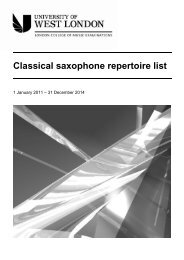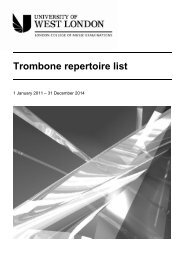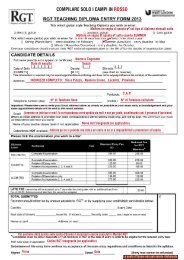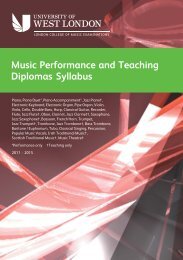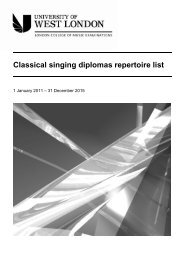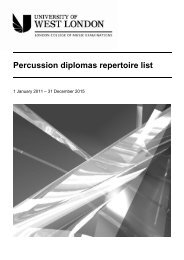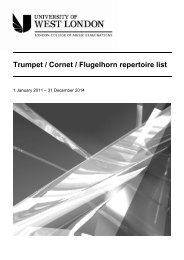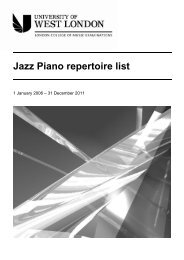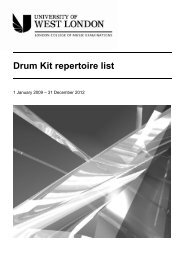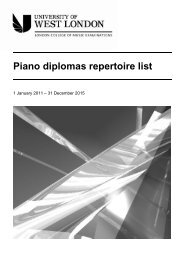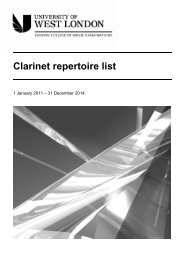LCM Exams - Jazz Flute Grades repertoire list - esamilcm.it
LCM Exams - Jazz Flute Grades repertoire list - esamilcm.it
LCM Exams - Jazz Flute Grades repertoire list - esamilcm.it
You also want an ePaper? Increase the reach of your titles
YUMPU automatically turns print PDFs into web optimized ePapers that Google loves.
<strong>Jazz</strong> <strong>Flute</strong> <strong>repertoire</strong> <strong>list</strong><br />
1 January 2007 – 31 December 2011
JAZZ FLUTE<br />
2007-2011<br />
2008 ed<strong>it</strong>ion<br />
Contents<br />
Page<br />
<strong>LCM</strong> Publications ................................................................ 3<br />
Grade 1 ............................................................................... 5<br />
Grade 2 ............................................................................... 6<br />
Grade 3 ............................................................................... 7<br />
Grade 4 ............................................................................... 8<br />
Grade 5 ............................................................................... 9<br />
Grade 6 ............................................................................... 10<br />
Grade 7 ............................................................................... 12<br />
Grade 8 ............................................................................... 14<br />
Musical Awareness ............................................................. 16<br />
Aural Tests .......................................................................... 18<br />
This <strong>repertoire</strong> <strong>list</strong> should be read in conjunction w<strong>it</strong>h the Syllabus for<br />
Graded Examinations in <strong>Jazz</strong> Performance. Copies are available free of<br />
charge from <strong>LCM</strong> Examinations (tel: 020 8231 2364) or from local<br />
representatives.<br />
Leisure Play examinations are also available, for candidates who wish to<br />
play pieces only. Please see Section 5 of the syllabus for details.<br />
This <strong>repertoire</strong> <strong>list</strong> is valid from 1 January 2007 until 31 December 2011.
<strong>LCM</strong> Examinations<br />
Director of Examinations<br />
John Howard BA PhD<br />
Chief Examiner in Music<br />
Philip Aldred BEd F<strong>LCM</strong><br />
Univers<strong>it</strong>y of West London<br />
<strong>LCM</strong> Examinations<br />
St Mary’s Road<br />
Ealing<br />
London<br />
W5 5RF<br />
tel: +44 (0)20 8231 2364<br />
fax: +44 (0)20 8231 2433<br />
email: lcm.exams@uwl.ac.uk<br />
uwl.ac.uk/lcmexams<br />
© Copyright 2011 by the Univers<strong>it</strong>y of West London, <strong>LCM</strong> Examinations<br />
2
<strong>LCM</strong> Publications<br />
The following <strong>LCM</strong> Publications are relevant to this syllabus:<br />
• LL161 <strong>Jazz</strong> Wind Handbook 1 (<strong>Grades</strong> 1-5)<br />
• LL162 <strong>Jazz</strong> Wind Handbook 2 (<strong>Grades</strong> 6-8)<br />
• LL189 Specimen Aural Tests<br />
• LL205 <strong>LCM</strong> Aural Handbook<br />
• LL203 <strong>Jazz</strong> Wind and Brass Backing Tracks CD<br />
<strong>LCM</strong> Publications are distributed by Music Exchange (tel: 0161 946 9301; email: mail@music-exchange.co.uk).<br />
A complete <strong>list</strong> of t<strong>it</strong>les may be found on their webs<strong>it</strong>e – www.music-exchange.co.uk<br />
Note on Pieces Requiring Improvisation (<strong>Grades</strong> 6-8)<br />
Alternative ed<strong>it</strong>ions of jazz standards are acceptable. Pieces requiring improvisation should consist of the ‘Head’<br />
and approximately two improvised choruses. CD backing tracks are optional. Live accompaniment is encouraged<br />
(e.g. Piano, Keyboard, Gu<strong>it</strong>ar, Rhythm section).<br />
3
JAZZ FLUTE: GRADE ONE<br />
Component 1 - Technical Work<br />
15 marks<br />
SCALES AND ARPEGGIOS<br />
(m.m. crotchet = c. 60 when played in quavers)<br />
Ascending and descending from memory. To be prepared tongued and slurred.<br />
G and F major (one octave)<br />
A melodic OR harmonic minor (candidate’s choice) (one octave)<br />
Pentatonic scale: G major (one octave)<br />
Component 2 - Performance<br />
60 marks<br />
Performance of three pieces: one from List A and two from List B.<br />
At least one piece must be selected from <strong>LCM</strong> <strong>Jazz</strong> Wind Handbook 1 (LL161).<br />
LIST A<br />
Tongue Tied OR Dotty <strong>LCM</strong> <strong>Jazz</strong> Wind Handbook 1 (<strong>LCM</strong> Publications)<br />
No.1 (Andante) OR No.2 (Moderato) Easy <strong>Jazz</strong> Singles for <strong>Flute</strong> (Russell Stokes) (Hunt Ed.)<br />
Strangers in the Night OR Daisy Bell <strong>Flute</strong> Basics (Sally Adams)<br />
(Faber; piano parts available separately)<br />
A Small Step OR Coo’s Blues OR Ready, Aim, Fire!<br />
Easy <strong>Jazz</strong>y ‘Tudes (Mark Nightingale)<br />
(Warwick Music)<br />
Bluebirds OR 60 Seconds Ballad OR Butternut Bossa<br />
Funky <strong>Flute</strong> Book1 (Heather Hammond)<br />
(Kevin Mayhew Ltd.)<br />
Swing Quaver section No. 4 OR 6 <strong>Jazz</strong> <strong>Flute</strong> Studies (James Rae) (Faber)<br />
LIST B<br />
Smooth Waltz <strong>LCM</strong> <strong>Jazz</strong> Wind Handbook 1 (<strong>LCM</strong> Publications)<br />
Seesaw OR Cruise Liner OR What’s the Score<br />
Microjazz <strong>Flute</strong> Collection Book 1 (Christopher Norton) (Faber)<br />
The Cobbler The Really Easy <strong>Flute</strong> Book (Faber)<br />
Activate OR Spirals UpBeat Book 1 (Alison Hounsome) (Subject Publications)<br />
Setting Off <strong>Jazz</strong> Routes (Malcolm Miles) (Camden Music)<br />
Kim’s Ballad Razzamajazz <strong>Flute</strong> (Sarah Watts) (Kevin Mayhew Ltd.)<br />
Waltz A New Tune a Day For <strong>Flute</strong> Book 1<br />
(Boston Music Co., CD backing available)<br />
Component 3 - Musical Awareness<br />
7 marks<br />
See pages 16-17.<br />
Component 4 - Creative Response Test<br />
10 marks<br />
This section of the examination will test the candidate’s abil<strong>it</strong>y to develop improvised phrasing at sight.<br />
Approximately one minute will be allowed to study the test, during which time the candidate may try the test if they<br />
wish.<br />
The pieces will consist of four bars in C major. Bars 1 and 2 will be wr<strong>it</strong>ten out. The candidate is required to play<br />
the opening phrase and a response phrase.<br />
Examples are provided in <strong>Jazz</strong> Wind Handbook 1.<br />
Component 5 - Aural Tests<br />
8 marks<br />
See pages 18-22. Specimen tests can be found in <strong>Jazz</strong> Wind Handbook 1.<br />
5
JAZZ FLUTE: GRADE TWO<br />
Component 1 - Technical Work<br />
15 marks<br />
SCALES AND ARPEGGIOS<br />
(m.m. crotchet = c. 60 when played in quavers)<br />
Ascending and descending from memory. To be prepared tongued and slurred.<br />
C major (one octave [upper octave]), D major (two octaves)<br />
D melodic OR harmonic minor (candidate’s choice) (two octaves)<br />
A and E melodic OR harmonic minor (candidate’s choice) (one octave)<br />
Pentatonic scales: C major (one octave [upper octave]), G major (one octave)<br />
Component 2 - Performance<br />
60 marks<br />
Performance of three pieces: one from List A and two from List B.<br />
At least one piece must be selected from <strong>LCM</strong> <strong>Jazz</strong> Wind Handbook 1 (LL161).<br />
LIST A<br />
Swing 12 OR Swing 11 <strong>LCM</strong> <strong>Jazz</strong> Wind Handbook 1 (<strong>LCM</strong> Publications)<br />
No.3 (Steadily) OR No.4 (Moderato) Easy <strong>Jazz</strong> Singles for <strong>Flute</strong> (Russell Stokes) (Hunt Ed.)<br />
The Roamin Gnomes OR <strong>Jazz</strong>min’s Waltz <strong>Flute</strong> Basics (Sally Adams) (Faber; piano parts available separately)<br />
Three-Step OR The Stinger OR Big Mama Easy <strong>Jazz</strong>y ‘Tudes (Mark Nightingale)<br />
(Warwick Music)<br />
Anticipation section No. 12 OR 15 <strong>Jazz</strong> <strong>Flute</strong> Studies (James Rae) (Faber)<br />
LIST B<br />
Homeward <strong>LCM</strong> <strong>Jazz</strong> Wind Handbook 1 (<strong>LCM</strong> Publications)<br />
Out and About OR North Circular Easy <strong>Jazz</strong>y <strong>Flute</strong> (James Rae) (Universal Ed<strong>it</strong>ion)<br />
Mango Juice OR A Stroll OR L<strong>it</strong>tle Lamb Microjazz <strong>Flute</strong> Collection Book 1 (Christopher Norton) (Faber)<br />
Embraceable You Mostly Ballads (IMP, CD backing included)<br />
Movie Buster OR Mellow Out Razzamajazz <strong>Flute</strong> (Sarah Watts) (Kevin Mayhew Ltd.)<br />
Vintage Steam <strong>Jazz</strong> Routes (Malcolm Miles) (Camden Music)<br />
Five Finger Blues A New Tune a Day For <strong>Flute</strong> Book 1<br />
(Boston Music Co., CD backing available)<br />
Funny Face Easy Gershwin for <strong>Flute</strong> (Paul Harris) (OUP)<br />
Component 3 - Musical Awareness<br />
7 marks<br />
See pages 16-17.<br />
Component 4 - Creative Response Test<br />
10 marks<br />
This section of the examination will test the candidate’s abil<strong>it</strong>y to develop improvised phrasing at sight.<br />
Approximately one minute will be allowed to study the test, during which time the candidate may try the test if they<br />
wish.<br />
The piece will consist of four bars in G major. Bars 1 and 2 will be wr<strong>it</strong>ten out. The candidate is required to play the<br />
opening phrase and a response phrase.<br />
Examples are provided in <strong>Jazz</strong> Wind Handbook 1.<br />
Component 5 - Aural Tests<br />
8 marks<br />
See pages 18-22. Specimen tests can be found in <strong>Jazz</strong> Wind Handbook 1.<br />
6
JAZZ FLUTE: GRADE THREE<br />
Component 1 - Technical Work<br />
15 marks<br />
SCALES AND ARPEGGIOS<br />
(m.m. crotchet = c. 60 when played in quavers)<br />
Ascending and descending from memory. To be prepared tongued and slurred.<br />
G, D, F major (two octaves)<br />
D, E, G melodic OR harmonic minor (candidate’s choice) (two octaves)<br />
Pentatonic scales: D and F major (one octave swung)<br />
Component 2 - Performance<br />
60 marks<br />
Performance of three pieces: one from List A and two from List B.<br />
At least one piece must be selected from <strong>LCM</strong> <strong>Jazz</strong> Wind Handbook 1 (LL161).<br />
LIST A<br />
Move Along OR <strong>Jazz</strong>y Waltz <strong>LCM</strong> <strong>Jazz</strong> Wind Handbook 1 (<strong>LCM</strong> Publications)<br />
No.20 (Moderato) OR No.21 (Vigoroso) Easy <strong>Jazz</strong> Singles for <strong>Flute</strong> (Russell Stokes) (Hunt Ed.)<br />
Theme from The Archers OR Flexible Friends (page 56)<br />
<strong>Flute</strong> Basics (Sally Adams) (Faber, piano parts available separately)<br />
Ernie’s Blues OR Skipping OR Slinky Easy <strong>Jazz</strong>y ‘Tudes (Mark Nightingale) (Warwick Music)<br />
Melodic section No. 33 OR 35 <strong>Jazz</strong> <strong>Flute</strong> Studies (James Rae) (Faber)<br />
LIST B<br />
Winding Road <strong>LCM</strong> <strong>Jazz</strong> Wind Handbook 1 (<strong>LCM</strong> Publications)<br />
Glad To Be Back OR Break Time Microjazz <strong>Flute</strong> Collection Book 1 (Christopher Norton) (Faber)<br />
‘S Wonderful OR Days of Wine and Roses OR Sol<strong>it</strong>ude<br />
Mostly Ballads<br />
(Warner Bros., CD backing included)<br />
Just Lounging About UpBeat Book 1 (Alison Hounsome) (Subject Pub.)<br />
Waltz for Richard <strong>Jazz</strong> Routes (Malcolm Miles) (Camden Music)<br />
Swanee OR s’Wonderful Easy Gershwin for <strong>Flute</strong> (Paul Harris) (OUP)<br />
Pink Lady <strong>Jazz</strong>in’ About (Pamela Wedgwood) (Faber)<br />
Oh Susannah A New Tune a Day for <strong>Flute</strong> Book 1<br />
(Boston Music Co., CD backing available)<br />
Component 3 - Musical Awareness<br />
7 marks<br />
See pages 16-17.<br />
Component 4 - Creative Response Test<br />
10 marks<br />
This section of the examination will test the candidate’s abil<strong>it</strong>y to develop improvised phrasing at sight.<br />
Approximately one minute will be allowed to study the test, during which time the candidate may try the test if they<br />
wish.<br />
The piece will consist of eight bars in F major, in a ‘swing’ style. Bars 1, 2, 5 and 6 will be given. Development will<br />
be required in bars 3, 4, 7 and 8.<br />
Examples are provided in <strong>Jazz</strong> Wind Handbook 1.<br />
Component 5 - Aural Tests<br />
8 marks<br />
See pages 18-22. Specimen tests can be found in <strong>Jazz</strong> Wind Handbook 1.<br />
7
JAZZ FLUTE: GRADE FOUR<br />
Component 1 - Technical Work<br />
15 marks<br />
SCALES AND ARPEGGIOS<br />
(m.m. crotchet = c. 72 when played in quavers)<br />
Ascending and descending from memory. To be prepared tongued and slurred, piano and forte.<br />
G, D, A, E, F, Eb major (two octaves)<br />
Ab major (one octave)<br />
E, F#, D, G, F melodic OR harmonic minor (candidate’s choice) (two octaves)<br />
Pentatonic scales: A and E major, F# and C# minor (two octaves swung)<br />
Blues scale: D (two octaves swung)<br />
Component 2 - Performance<br />
60 marks<br />
Performance of three pieces, one from List A and two from List B.<br />
At least one piece must be selected from <strong>LCM</strong> <strong>Jazz</strong> Wind Handbook 1 (LL161).<br />
LIST A<br />
Heavy Funk OR Bluesy <strong>LCM</strong> <strong>Jazz</strong> Wind Handbook 1 (<strong>LCM</strong> Publications)<br />
No.24 (Ragtime) OR No.25 (W<strong>it</strong>h Life) Easy <strong>Jazz</strong> Singles for <strong>Flute</strong> (Russell Stokes) (Hunt Ed.)<br />
Playtime Rag OR Emily’s Half Term Blues <strong>Flute</strong> Basics (Sally Adams) (Faber, piano parts available separately)<br />
Hillbilly OR Passion Fru<strong>it</strong> Samba Easy <strong>Jazz</strong>y ‘Tudes (Mark Nightingale) (Warwick Music)<br />
Melodic section No. 40 OR 44 <strong>Jazz</strong> <strong>Flute</strong> Studies (James Rae) (Faber)<br />
LIST B<br />
Night Sky <strong>LCM</strong> <strong>Jazz</strong> Wind Handbook 1 (<strong>LCM</strong> Publications)<br />
Love is Here to Stay OR Sweet and Low Down Easy Gershwin (Paul Harris)<br />
(OUP)<br />
Song OR Springboard Microjazz <strong>Flute</strong> Collection 2(Christopher Norton) (Faber)<br />
In a Sentimental Mood OR Heartlight Mostly Ballads (Warner Bros., CD backing included)<br />
Transformation <strong>Jazz</strong> Routes (Malcolm Miles) (Camden Music)<br />
Singin’ in the Rain Take the Lead (Bumper Book) (Faber)<br />
Free Fall <strong>Jazz</strong>in’ About (Pamela Wedgwood) (Faber)<br />
Oh, Lady be Good OR Love Walked In Easy Gershwin for <strong>Flute</strong> (Paul Harris) (OUP)<br />
Bye Bye Blackbird Swing Swing Swing (Jamey Aebersold Vol. 39)<br />
[2 choruses to be played w<strong>it</strong>h embellishments/improvisation in 2 nd chorus] (<strong>Jazz</strong>wise, CD backing included)<br />
Component 3 - Musical Awareness<br />
7 marks<br />
See pages 16-17.<br />
Component 4 - Creative Response Test<br />
10 marks<br />
This section of the examination will test the candidate’s abil<strong>it</strong>y to develop improvised phrasing at sight.<br />
Approximately one minute will be allowed to study the test, during which time the candidate may try the test if they<br />
wish.<br />
The piece will consist of eight bars in D major or B minor, in a ‘swing’ or ‘straight’ style. The first four bars will be<br />
given.<br />
Examples are provided in <strong>Jazz</strong> Wind Handbook 1.<br />
Component 5 - Aural Tests<br />
8 marks<br />
See pages 18-22. Specimen tests can be found in <strong>Jazz</strong> Wind Handbook 1.<br />
8
JAZZ FLUTE: GRADE FIVE<br />
Component 1 - Technical Work<br />
15 marks<br />
SCALES AND ARPEGGIOS<br />
(m.m. crotchet = c. 72 when played in quavers)<br />
Ascending and descending from memory. To be prepared tongued and slurred, piano and forte.<br />
D, A, E, F, Bb, Eb, Ab major (two octaves)<br />
F#, C#, D, G, C, F melodic OR harmonic minor (candidate’s choice) (two octaves)<br />
Pentatonic scales: G major, E minor (two octaves swung)<br />
Blues scales: G and E (two octaves swung)<br />
Chromatic scale beginning on D (two octaves)<br />
Dominant 7th in the key of C, resolving on the tonic (two octaves swung)<br />
Component 2 - Performance<br />
60 marks<br />
Performance of three pieces, one from List A and two from List B.<br />
At least one piece must be selected from <strong>LCM</strong> <strong>Jazz</strong> Wind Handbook 1 (LL161).<br />
LIST A<br />
Silvery OR Shift Riff <strong>LCM</strong> <strong>Jazz</strong> Wind Handbook 1 (<strong>LCM</strong> Publications)<br />
No.29 (W<strong>it</strong>h Life) OR No.30 (Allegretto) Easy <strong>Jazz</strong> Singles for <strong>Flute</strong> (Russell Stokes) (Hunt Ed.)<br />
No.58 (Relaxed Tempo) OR No.59 (Steady Swing Feel)<br />
Progressive <strong>Jazz</strong> Studies (James Rae)<br />
(Faber)<br />
The Turkey OR Transpos<strong>it</strong>ion Blues Easy <strong>Jazz</strong>y ‘Tudes (Mark Nightingale) (Warwick Music)<br />
Tonal<strong>it</strong>ies section No. 55 OR 56 <strong>Jazz</strong> <strong>Flute</strong> Studies (James Rae) (Faber)<br />
LIST B<br />
Southern Shuffle (w<strong>it</strong>h improvisation) <strong>LCM</strong> <strong>Jazz</strong> Wind Handbook 1 (<strong>LCM</strong> Publications)<br />
It Ain’t Necessarily So OR Fascinating Rhythm Easy Gershwin (Paul Harris)<br />
(OUP)<br />
Love Song OR Folk Shuffle Microjazz for <strong>Flute</strong> (Christopher Norton) (Faber)<br />
The Girl from Ipanema OR One Note Samba Mostly Ballads (Warner Bros., CD backing included)<br />
Emily Movie Songs (Carl Strommen) (IMP., CD backing included)<br />
Blah-blah-blah! <strong>Jazz</strong> Routes (Malcolm Miles) (Camden Music)<br />
Just Passing By OR Tequila Sunrise <strong>Jazz</strong>in’ About (Pamela Wedgwood) (Faber)<br />
Poor Butterfly Swing Swing Swing (Jamey Aebersold Vol. 39)<br />
[2 choruses to be played w<strong>it</strong>h embellishments/improvisation in 2 nd chorus] (<strong>Jazz</strong>wise, CD backing included)<br />
Component 3 - Musical Awareness<br />
7 marks<br />
See pages 16-17.<br />
Component 4 - Creative Response Test<br />
10 marks<br />
This section of the examination will test the candidate’s abil<strong>it</strong>y to develop improvised phrasing at sight.<br />
Approximately one minute will be allowed to study the test, during which time the candidate may try the test if they<br />
wish.<br />
The piece will consist of eight bars in Bb major or G minor, in a ‘swing’ or ‘straight’ style. The first four bars will be<br />
given.<br />
Examples are provided in <strong>Jazz</strong> Wind Handbook 1.<br />
Component 5 - Aural Tests<br />
8 marks<br />
See pages 18-22. Specimen tests can be found in <strong>Jazz</strong> Wind Handbook 1.<br />
9
JAZZ FLUTE: GRADE SIX<br />
Component 1 - Technical Work<br />
15 marks<br />
SCALES AND ARPEGGIOS<br />
(No metronome rate is set; however, candidates should demonstrate a fluent command of the instrument.)<br />
Ascending and descending from memory. To be prepared tongued and slurred, piano and forte.<br />
Major scales up to 5 sharps and 5 flats (two octaves)<br />
Minor scales up to 4 sharps and 4 flats (melodic OR harmonic, candidate’s choice) (two octaves)<br />
Whole tone scale beginning on C (two octaves)<br />
Blues scales: A, F#, C (two octaves swung), B (one octave swung)<br />
Dominant 7ths in the keys of C, D, Bb, resolving on the tonic (two octaves swung)<br />
Diminished 7th beginning on D (two octaves swung)<br />
Add<strong>it</strong>ional chords/arpeggios: D7, Dmin7, D6, Dmin6 (two octaves swung)<br />
Component 2 - Performance<br />
60 marks<br />
Performance of three pieces, one from List A and two from List B (Improvisations).<br />
At least one piece must be selected from <strong>LCM</strong> <strong>Jazz</strong> Wind Handbook 2 (LL162).<br />
LIST A<br />
Up Tempo Blues (w<strong>it</strong>h improvisation) <strong>LCM</strong> <strong>Jazz</strong> Wind Handbook 2 (<strong>LCM</strong> Publications)<br />
Heartlight OR A House is Not a Home OR Girl from Ipanema<br />
Mostly Ballads<br />
(Warner Bros., CD backing included)<br />
Sweet Georgia Brown Movie Songs (Carl Strommen) (IMP, CD backing included)<br />
I Ain’t Got Nothin’ But the Blues OR Night Train<br />
Solo Plus, Boogie and Blues<br />
(Amsco)<br />
Five Brew Easy <strong>Jazz</strong>y ‘Tudes (Mark Nightingale) (Warwick Music)<br />
Tonal<strong>it</strong>ies section No. 58 OR 60 <strong>Jazz</strong> <strong>Flute</strong> Studies (James Rae) (Faber)<br />
Green Onions Instrumental Play-along: Soul H<strong>it</strong>s (Hal Leonard, CD backing included)<br />
LIST B (IMPROVISATIONS)<br />
<strong>Jazz</strong> Waltz Blues (compos<strong>it</strong>ion and improvisation)<br />
<strong>LCM</strong> <strong>Jazz</strong> Wind Handbook 2<br />
(<strong>LCM</strong> Publications)<br />
Autumn Leaves OR Another You Autumn Leaves (Jamey Aebersold Vol.44)<br />
(<strong>Jazz</strong>wise, CD backing included)<br />
Summertime OR C Jam Blues OR The Preacher <strong>Jazz</strong> Improvisation Series: Approaching the Standards Volume 1<br />
(Dr Willie Hill)<br />
(Warner Bros., CD backing included)<br />
Own compos<strong>it</strong>ion in the style of a Blues (w<strong>it</strong>h improvised section)<br />
Compos<strong>it</strong>ion of a head and improvisation over two choruses of e<strong>it</strong>her Blues (track 7 OR 8)<br />
How to Play <strong>Jazz</strong> and Improvise (Jamey Aebersold Vol. 1)<br />
(<strong>Jazz</strong>wise, CD backing included)<br />
S<strong>it</strong>tin’ on the Dock of the Bay Play Soul (Richard Harris) (Faber, CD backing included)<br />
Blue Room Swing Swing Swing (Jamey Aebersold Vol. 39)<br />
(<strong>Jazz</strong>wise, CD backing included)<br />
Long-Meter <strong>Jazz</strong>/Rock OR Bird Blues OR Fast Blues in F<br />
Nothin’ But Blues (Jamey Aebersold Vol. 2)<br />
(<strong>Jazz</strong>wise, CD backing included)<br />
Watermelon Man Maiden Voyage (Jamey Aebersold Vol. 54)<br />
(<strong>Jazz</strong>wise, CD backing included)<br />
Here comes McBride Dave Brubeck (Jamey Aebersold Vol. 105)<br />
(<strong>Jazz</strong>wise, CD backing included)<br />
Component 3 - Musical Awareness<br />
7 marks<br />
See pages 16-17.<br />
10
Component 4 - Creative Response Test<br />
10 marks<br />
This section of the examination will test the candidate’s abil<strong>it</strong>y to develop improvised phrasing at sight.<br />
Approximately one minute will be allowed to study the test, during which time the candidate may try the test if they<br />
wish.<br />
The piece will consist of eight bars, up to 3 sharps or 3 flats, in a ‘swing’ or ‘straight’ style. Two bars will be given,<br />
plus chord indications. Blues scales, pentatonic scales and modes related to the Technical Work could be applied<br />
in the piece.<br />
Examples are provided in <strong>Jazz</strong> Wind Handbook 2.<br />
Component 5 - Aural Tests<br />
8 marks<br />
See pages 18-22. Specimen tests can be found in <strong>Jazz</strong> Wind Handbook 2.<br />
11
JAZZ FLUTE: GRADE SEVEN<br />
Component 1 - Technical Work<br />
SCALES AND ARPEGGIOS<br />
(No metronome rate is set; however, candidates should demonstrate a fluent command of the instrument.)<br />
Ascending and descending from memory. To be prepared tongued and slurred, piano and forte.<br />
All majors and minors (melodic OR harmonic, candidate’s choice) (two octaves)<br />
Whole tone scales beginning on C and C# (two octaves)<br />
Chromatic scale beginning on A (two octaves)<br />
Blues scales: A and F# (two octaves swung)<br />
Dorian mode beginning on F and E (two octaves swung)<br />
Dominant 7ths in the keys of Db and B, resolving on the tonic (two octaves swung)<br />
Diminished 7th beginning on G (two octaves swung)<br />
Add<strong>it</strong>ional chords/arpeggios: F7, Fmin7, F6, Fmin6 (two octaves swung)<br />
Component 2 - Performance<br />
Performance of three pieces, one from List A and two from List B (Improvisations).<br />
At least one piece must be selected from <strong>LCM</strong> <strong>Jazz</strong> Wind Handbook 2 (LL162).<br />
15 marks<br />
60 marks<br />
LIST A<br />
One Way <strong>LCM</strong> <strong>Jazz</strong> Wind Handbook 2 (<strong>LCM</strong> Publications)<br />
One Note Samba Mostly Ballads (Warner Bros., CD backing included)<br />
As Time Goes By OR Over the Rainbow OR On Green Dolphin Street<br />
Movie Songs (Carl Strommen) (IMP, CD backing included)<br />
Save Your Love for Me Solo Plus, Boogie and Blues (Amsco)<br />
Fly me to the Moon<br />
<strong>Jazz</strong> Classics (Instrumental Play-Along)<br />
(Hal Leonard, CD backing included)<br />
No. 66 <strong>Jazz</strong> <strong>Jazz</strong> Waltz <strong>Jazz</strong> <strong>Flute</strong> Studies (James Rae) (Faber)<br />
Stand by Me<br />
Instrumental Play-along: Soul H<strong>it</strong>s<br />
(Hal Leonard, CD backing included)<br />
LIST B (IMPROVISATIONS)<br />
Minor Groove (compos<strong>it</strong>ion and improvisation) <strong>LCM</strong> <strong>Jazz</strong> Wind Handbook 2<br />
(<strong>LCM</strong> Publications)<br />
Bright Blues OR Fast Blues Alfred Master Tracks (<strong>Jazz</strong>) (Alfred, CD backing included)<br />
The Very Thought of You Body and Soul (Jamey Aebersold Vol. 41)<br />
(<strong>Jazz</strong>wise, CD backing included)<br />
Wave OR L<strong>it</strong>tle Boat OR Summer Samba Bossa Novas (Jamey Aebersold Vol. 31)<br />
(<strong>Jazz</strong>wise, CD backing included)<br />
Now’s the Time OR Honeysuckle Rose OR Perdido<strong>Jazz</strong> Improvisation Series: Approaching the Standards Volume 2<br />
(Dr Willie Hill)<br />
(Warner Bros., CD backing included)<br />
A creative response to Track 9: Cycle of Dominant 7 th chords<br />
How to Play <strong>Jazz</strong> and Improvise (Jamey Aebersold Vol. 1)<br />
(<strong>Jazz</strong>wise, CD backing included)<br />
Own compos<strong>it</strong>ion in the style of a <strong>Jazz</strong> Waltz (w<strong>it</strong>h improvised section)<br />
Work Song Cannonball Adderley (Jamey Aebersold Vol. 13)<br />
(<strong>Jazz</strong>wise, CD backing included)<br />
Trav’lin’ Blues Dave Brubeck (Jamey Aebersold Vol. 105)<br />
(<strong>Jazz</strong>wise, CD backing included)<br />
I Could Wr<strong>it</strong>e a Book OR Someone to Watch Over Me<br />
Romantic Ballads (Jamey Aebersold Vol. 110)<br />
(<strong>Jazz</strong>wise, CD backing included)<br />
Component 3 - Musical Awareness<br />
See pages 16-17.<br />
7 marks<br />
12
Component 4 - Creative Response Test<br />
10 marks<br />
This section of the examination will test the candidate’s abil<strong>it</strong>y to develop improvised phrasing at sight.<br />
Approximately one minute will be allowed to study the test, during which time the candidate may try the test if they<br />
wish.<br />
The piece will consist of eight bars, up to 4 sharps or 4 flats, in a ‘swing’ or ‘straight’ style. Two bars will be given,<br />
plus chord indications. Blues scales, pentatonic scales and modes related to the Technical Work could be applied<br />
in the pieces.<br />
Examples are provided in <strong>Jazz</strong> Wind Handbook 2.<br />
Component 5 - Aural Tests<br />
See pages 18-22. Specimen tests can be found in <strong>Jazz</strong> Wind Handbook 2.<br />
8 marks<br />
13
JAZZ FLUTE: GRADE EIGHT<br />
Theory of Music Grade Five (or alternative) must have been passed; see Regulations.<br />
Component 1 - Technical Work<br />
15 marks<br />
SCALES AND ARPEGGIOS<br />
(No metronome rate is set; however, candidates should demonstrate a fluent command of the instrument.)<br />
Ascending and descending from memory. To be prepared tongued and slurred, piano, forte and swung.<br />
C major and C minor (three octaves), all other majors and minors (two octaves) (melodic OR harmonic minor,<br />
candidate’s choice)<br />
Whole tone scales beginning on C and C# (two octaves)<br />
Chromatic scale beginning on B (two octaves)<br />
Blues scales: B and Eb (two octaves)<br />
Modes: Dorian on E and F, Lydian on E and F, Mixolydian on E and F (two octaves)<br />
Dominant 7ths in all keys, resolving on the tonic (two octaves)<br />
Diminished 7ths beginning on C, C# and D (two octaves)<br />
Add<strong>it</strong>ional chords/arpeggios: E7, E6, Emin7, Emin6 (two octaves)<br />
Component 2 - Performance<br />
60 marks<br />
Performance of three pieces, one from List A and two from List B (Improvisations).<br />
At least one piece must be selected from <strong>LCM</strong> <strong>Jazz</strong> Wind Handbook 2 (LL162).<br />
LIST A<br />
Low Roller <strong>LCM</strong> <strong>Jazz</strong> Wind Handbook 2 (<strong>LCM</strong> Publications)<br />
Nice Work If You Can Get It OR A Foggy Day OR Fascinating Rhythm<br />
Gershwin By Special Arrangement (Carl Strommen)<br />
(Warner Bros., CD backing included)<br />
Harlem Nocturne OR Fever Guest Spot: Classic Blues (Wise, CD backing included)<br />
One Note Samba<br />
Guest Spot: 21 Classic H<strong>it</strong>s Playalong for <strong>Flute</strong> – Blue Book<br />
(Wise, CD backing included)<br />
II-V7-I section No. 75 OR 76 <strong>Jazz</strong> <strong>Flute</strong> Studies (James Rae) (Faber)<br />
LIST B (IMPROVISATIONS)<br />
Samba Time (compos<strong>it</strong>ion and improvisation) <strong>LCM</strong> <strong>Jazz</strong> Wind Handbook 2 (<strong>LCM</strong> Publications)<br />
Rhythm Changes Medium Tempo OR Up Tempo Alfred Masterworks (<strong>Jazz</strong>)<br />
(Alfred)<br />
Time After Time OR The Very Thought Of You Body and Soul (Jamey Aebersold Vol.41)<br />
(<strong>Jazz</strong>wise, CD backing included)<br />
Killer Joe OR Take The ‘A’ Train OR Cottontail <strong>Jazz</strong> Improvisation Series: Approaching the Standards Volume 3<br />
(Dr Willie Hill)<br />
(Warner Bros., CD backing included)<br />
Own compos<strong>it</strong>ion based on II-V-I sequence (w<strong>it</strong>h improvised section)<br />
A creative response to Track 10: 24 Measure Song [maximum 3 choruses]<br />
How to Play <strong>Jazz</strong> and Improvise (Jamey Aebersold Vol. 1)<br />
(<strong>Jazz</strong>wise, CD backing included)<br />
St. Thomas OR Doxy OR Footprints Sonny Rollins (Jamey Aebersold Vol. 8)<br />
(<strong>Jazz</strong>wise, CD backing included)<br />
The Duke Dave Brubeck (Jamey Aebersold Vol. 105)<br />
(<strong>Jazz</strong>wise, CD backing included)<br />
Serenata OR When Lights are Low Collectors Items (Jamey Aebersold Vol. 52)<br />
(<strong>Jazz</strong>wise, CD backing included)<br />
Once I Loved <strong>Jazz</strong> Bossa Novas (Jamey Aebersold Vol. 31)<br />
(<strong>Jazz</strong>wise, CD backing included)<br />
Component 3 - Musical Awareness<br />
7 marks<br />
See pages 16-17.<br />
14
Component 4 - Creative Response Test<br />
10 marks<br />
This section of the examination will test the candidate’s abil<strong>it</strong>y to develop improvised phrasing at sight.<br />
Approximately one minute will be allowed to study the test, during which time the candidate may try the test if they<br />
wish.<br />
The piece will consist of up to 12 bars, up to 5 sharps or 5 flats, in a ‘swing’ or ‘straight’ style. The first 2 bars will be<br />
given, and chord indications provided over the remainder of the piece.<br />
Examples are provided in <strong>Jazz</strong> Wind Handbook 2.<br />
Component 5 - Aural Tests<br />
8 marks<br />
See pages 18-22. Specimen tests can be found in <strong>Jazz</strong> Wind Handbook 2.<br />
15
Musical Awareness<br />
Notes:<br />
1. All questions and answers are verbal. Candidates are not expected to demonstrate on their instrument or to<br />
sing; but they may choose to do so if they feel that this would clarify their answer. Responses to questions<br />
related to the Handbook Exercises may include clapping / tapping.<br />
2. There is no set form of words, or number of questions. Examiners are encouraged to conduct the tests in a<br />
flexible and conversational manner. The number of questions asked, and the content of the questions, may<br />
differ from candidate to candidate. However, the prime focus will always be the music performed in the<br />
Performance section of the exam, together w<strong>it</strong>h the Handbook Exercise .<br />
3. The knowledge required is cumulative for <strong>Grades</strong> 1-8; ie. any knowledge required in earlier grades is required<br />
for later grades. However, in the case of the Handbook Exercises, examiners will refer only to the exercise<br />
set for the particular grade.<br />
4. Although accuracy and appropriateness of response are the principal cr<strong>it</strong>eria of assessment, examiners will<br />
also look for articulacy, use of correct terminology, and a sense of engagement w<strong>it</strong>h, and understanding of, the<br />
music performed.<br />
Requirements:<br />
GRADES 1 AND 2<br />
Candidates should be able to:<br />
• name, and explain the meaning of, all basic notational elements in the music performed in the Performance<br />
component of the exam, including: staff, bars and bar-lines, clefs, p<strong>it</strong>ches of individual notes, rhythmic<br />
values of notes and rests (including dotted notes), key and time signatures, accidentals, dynamics,<br />
articulation markings, phrases, ornaments, and any add<strong>it</strong>ional markings;<br />
• explain which is their favour<strong>it</strong>e piece and why;<br />
• assign simple descriptive words to pieces to describe their mood ('happy', 'sad', 'bouncy', 'jazzy', 'gentle',<br />
etc.);<br />
• respond to questions relating to the Grade 1 or 2 Rhythm and Improvisation Exercise in the <strong>Jazz</strong> Wind<br />
Handbook 1.<br />
GRADE 3<br />
In add<strong>it</strong>ion to the requirements for <strong>Grades</strong> 1 and 2, candidates may be asked to:<br />
• identify intervals up to and including a fifth by numerical value only (eg. 'second', 'fourth', etc.);<br />
• demonstrate an understanding of basic chord symbols;<br />
• describe the mood or character of pieces using appropriate descriptive terminology ('fast and lively', 'gentle<br />
and flowing', 'like a dance', etc.);<br />
• identify contrasts of mood w<strong>it</strong>hin pieces;<br />
• discuss any pictorial or descriptive element of the music;<br />
• respond to questions relating to the Grade 3 Rhythm and Improvisation Exercise in the <strong>Jazz</strong> Wind<br />
Handbook 1.<br />
GRADE 4<br />
In add<strong>it</strong>ion to the requirements for <strong>Grades</strong> 1-3, candidates may be asked to:<br />
• identify intervals up to and including an octave by numerical value only (eg. 'fourth', 'seventh', etc.);<br />
• demonstrate basic knowledge of composers and/or famous performers of the music performed, including<br />
their national<strong>it</strong>y and approximate dates;<br />
• discuss their approaches to learning the pieces, and to identify any particular difficulties (musical or<br />
technical) which were encountered;<br />
• respond to questions relating to the Grade 4 Rhythm and Improvisation Exercise in the <strong>Jazz</strong> Wind<br />
Handbook 1.<br />
16
GRADE 5<br />
In add<strong>it</strong>ion to the requirements for <strong>Grades</strong> 1-4, candidates may be asked to:<br />
• identify intervals up to and including an octave by number and type (eg. 'Major 2nd', 'Perfect 4th', etc.);<br />
• demonstrate knowledge of basic formal structures (eg. contrasting or repeated sections);<br />
• identify principal modulations (by naming the new key or <strong>it</strong>s relationship to the home key);<br />
• identify major and minor chords as occurring in the music (e<strong>it</strong>her as chords or as melodic patterns);<br />
• demonstrate knowledge of pentatonic and blues scale structures;<br />
• respond to questions relating to the Grade 5 Rhythm and Improvisation Exercise in the <strong>Jazz</strong> Wind<br />
Handbook 1.<br />
GRADE 6<br />
In add<strong>it</strong>ion to the requirements for <strong>Grades</strong> 1-5, candidates may be asked to:<br />
• demonstrate knowledge of blues structures, chord structures, and modes in the major scale;<br />
• demonstrate sty<strong>list</strong>ic understanding and awareness;<br />
• respond to questions on musical influences;<br />
• discuss their personal responses to the music performed: the extent to which they like or dislike <strong>it</strong>, or find <strong>it</strong><br />
challenging or rewarding, and why;<br />
• approaches to learning the music, including the use of certain techniques, and aspects of interpretation;<br />
• demonstrate a self-cr<strong>it</strong>ical awareness of their own performance, indicating to the examiner which aspects of<br />
their performance they were happy or unhappy w<strong>it</strong>h, and why.<br />
GRADE 7<br />
In add<strong>it</strong>ion to the requirements for <strong>Grades</strong> 1-6, candidates may be asked to:<br />
• demonstrate knowledge of II-V-I patterns (G, C and F majors only) and the circle of fifths;<br />
• give basic biographical information about the composers and/or famous performers of the music<br />
performed;<br />
• demonstrate awareness of the historical and sty<strong>list</strong>ic context of the music;<br />
• demonstrate a widening musical awareness a l<strong>it</strong>tle beyond the music performed.<br />
GRADE 8<br />
In add<strong>it</strong>ion to the requirements for <strong>Grades</strong> 1-7, candidates may be asked to:<br />
• demonstrate knowledge of tr<strong>it</strong>one subst<strong>it</strong>utions, sus chords and turnarounds;<br />
• identify other pieces by the same composers;<br />
• identify any interval by number and type;<br />
• discuss w<strong>it</strong>h the examiner a range of issues arising from the music performed, demonstrating evidence of a<br />
rounded musical awareness, in terms both of the <strong>repertoire</strong> <strong>it</strong>self, and the candidate's response to <strong>it</strong> as a<br />
performer.<br />
17
Aural Tests<br />
Notes:<br />
1. GRADE 1 TEST 1(b); GRADE 3 TEST 2(b): where a candidate wishes to respond to e<strong>it</strong>her of these tests in<br />
the alternative manner as specified, the examiner must be informed in advance of the tests being<br />
administered. This may be done e<strong>it</strong>her via the Centre representative or attendant on the day (in advance of the<br />
examination), or by the candidate (in the examination, in advance of the tests).<br />
2. In tests where the identification of note values (rhythmic values) is required, such as Grade 2, test 1(c),<br />
candidates are required to respond by <strong>list</strong>ing the rhythmic values in order, e.g. 'minim, crotchet, crotchet' or<br />
'minim, four quavers'.<br />
3. In tests where a sung response is required, candidates may use any clear and appropriate syllable or vowel<br />
sound (e.g. 'ah', 'la', 'oo', etc.) They may also hum or whistle. Candidates may request tests to be transposed if<br />
required by their vocal range. Candidates may play back such tests on their instrument if they prefer; in this<br />
case, examiners must be informed prior to the administration of the tests (see note 1 above).<br />
4. In tests where responses describing p<strong>it</strong>ch are required, candidates may use letter-names (A, B, C, etc.), tonic<br />
sol-fa (doh, re mi, etc.), or number (1, 2, 3, etc., or 1st, 2nd, 3rd, etc.) (Where a minor key is used, <strong>it</strong> will be<br />
assumed that doh=tonic.)<br />
5. Please note that from Grade 2 onwards, candidates are required to beat time (i.e. conduct), NOT to tap or clap<br />
the pulse. They may join in during the in<strong>it</strong>ial playing, or a second playing may be given.<br />
6. Candidates may request any test to be given one repeat playing w<strong>it</strong>hout loss of marks.<br />
7. Please note that in all cases, examiners will use a piano to conduct the tests. Examiners will ask<br />
candidates to stand or s<strong>it</strong> in such a pos<strong>it</strong>ion that they cannot see the piano keyboard.<br />
8. Please note that the printed wording is a guide only. Examiners are encouraged to conduct the tests in a<br />
conversational manner.<br />
Requirements:<br />
GRADE 1<br />
Rhythm<br />
A short harmonised passage, of approximately 6-8 bars in length, will be played. The passage will be in<br />
e<strong>it</strong>her 2/4 or 3/4 time. Candidates will be asked to:<br />
1 (a) identify the time signature as “2” or “3” time (2 marks).<br />
1 (b) clap or tap on each pulse beat, in time, in 2 or 3 time, accenting the first beat of each bar, as the examiner<br />
plays the passage again (2 marks).<br />
Candidates may elect to respond to tests 1(a) and 1(b) in reverse order. In this case, the examiner should<br />
be informed in advance of the tests being administered (see Note 1 above).<br />
P<strong>it</strong>ch<br />
Two notes of different p<strong>it</strong>ches will be played, one after the other. Candidates will be asked to:<br />
2 (a) identify as “first” or “second” which of the two notes is EITHER the higher OR the lower, at the examiner's<br />
discretion (1 mark).<br />
The two notes will be played again. Candidates will be asked to:<br />
2 (b) sing back one of the two notes (EITHER the first OR the second, at the examiner's<br />
discretion) (1 mark).<br />
The key-chord of a major key will be played, followed by a short unharmonised melody in the same key, of<br />
approximately 4 bars in length. The examiner will stop playing before the final (tonic) note. The candidate<br />
will be asked to:<br />
2 (c) sing clearly the missing final tonic (2 marks).<br />
18
GRADE 2<br />
Rhythm<br />
A short harmonised passage, of approximately 8 bars in length, will be played. The passage will be in<br />
e<strong>it</strong>her 3/4 or 4/4 time. Candidates will be asked to:<br />
1 (a) identify the time signature as "3" or "4" time (1 mark).<br />
1 (b) beat (conduct) time, w<strong>it</strong>h a clear beat-shape (conducting pattern), in time w<strong>it</strong>h the examiner’s playing, as<br />
the examiner plays the passage again (1 mark).<br />
The examiner will select one bar from the passage, and will play <strong>it</strong> in an unharmonised version.<br />
Candidates will be asked to:<br />
1 (c) identify and describe the note values (rhythmic values of the notes) in the bar (2 marks).<br />
P<strong>it</strong>ch<br />
A major or minor triad will be played, followed by one note taken from the triad. Candidates will be asked<br />
to:<br />
2 (a) identify the note as “bottom, middle or top” OR “Doh, Mi or Soh” OR “root, 3rd or 5th” (candidate's choice)<br />
(1 mark).<br />
The triad will be played again. Candidates will be asked to:<br />
2 (b) state if the triad is major or minor (1 mark).<br />
The key-chord of a major key (C, F, G, and D majors only) will be played, and the key stated, followed by<br />
the first five notes of the scale in ascending order. The examiner will then play any ONE of these notes<br />
again. Candidates will be asked to:<br />
2 (c) identify the note, EITHER by letter name OR by tonic sol-fa name OR by number (1, 2, 3, 4 or 5) as elected<br />
by the candidate (1 mark).<br />
The test will be repeated, using a different example (1 mark).<br />
GRADE 3<br />
Rhythm<br />
A short harmonised passage, of approximately 8 bars in length, will be played. The passage will be in 6/8<br />
time. Candidates will be asked to:<br />
1 (a) beat (conduct) time, w<strong>it</strong>h a clear beat-shape (conducting pattern), 2 beats in the bar (NOT 6 beats in the<br />
bar), in time w<strong>it</strong>h the examiner’s playing, as the examiner plays the passage again (1 mark).<br />
The candidate will be shown three lines of music (marked 1, 2 and 3), each of which will contain four<br />
individual bars of music in 6/8 time (marked a, b, c and d). The examiner will indicate which line of music is<br />
being used. One of the bars on that line will be played, twice. Candidates will be asked to:<br />
1 (b) indicate which bar (a, b, c or d) has been played (1 mark).<br />
The test will be repeated, using a different example (1 mark).<br />
P<strong>it</strong>ch<br />
An interval will be played twice, once w<strong>it</strong>h the p<strong>it</strong>ches sounded successively, and once w<strong>it</strong>h the p<strong>it</strong>ches<br />
sounded together. The intervals will be restricted to the following: Major 2nd, Major 3rd, Perfect 4th, Perfect<br />
5th. Candidates will be asked to:<br />
2(a) identify the interval, by numerical value only (2nd, 3rd, 4th, 5th) (1 mark).<br />
The test will be repeated, using a different interval (1 mark).<br />
The key-chord of a major or minor key (C, G, D, F and Bb majors; A and E minors only) will be played, and<br />
the key stated. A short unharmonised melody, in the same key, of approximately 3 bars in length, will be<br />
played, twice. Rhythms will be lim<strong>it</strong>ed to crotchets, quavers, minims, dotted minims and semibreves.<br />
Candidates will be asked to:<br />
2 (b) sing back the melody (3 marks).<br />
Candidates may elect to respond to test 2(b) by playing the melody on their instrument, instead of singing.<br />
In this case, the examiner should be informed in advance of the tests being administered (see note 1<br />
above).<br />
19
GRADE 4<br />
Rhythm<br />
A short harmonised passage, of approximately 8 bars in length, will be played. The passage will be in<br />
e<strong>it</strong>her 2/4, 3/4, 4/4 or 6/8 time. Candidates will be asked to:<br />
1 (a) beat (conduct) time, w<strong>it</strong>h a correct and clear beat shape (conducting pattern) according to the time<br />
signature of the music, in time w<strong>it</strong>h the examiner's playing, as the examiner plays the passage again.<br />
(Passages in 6/8 time should be conducted w<strong>it</strong>h a 2-beat pattern). (2 marks).<br />
A short phrase, of approximately 2 bars in length, taken from the passage, will be played in an<br />
unharmonised version, twice. The phrase will include no rhythmic values shorter than a semiquaver, but<br />
may include simple dotted patterns. Candidates will be asked to:<br />
1 (b) clap or tap back the rhythm of the phrase (2 marks).<br />
P<strong>it</strong>ch<br />
An interval will be played twice, once w<strong>it</strong>h the p<strong>it</strong>ches sounded successively, and once w<strong>it</strong>h the p<strong>it</strong>ches<br />
sounded together. The interval will be restricted to any major, minor or perfect interval up to and including<br />
an octave. Candidates will be asked to:<br />
2(a) identify the interval, by numerical value and type (1 mark).<br />
The test will be repeated, using a different interval (1 mark).<br />
The candidate will be shown three similar versions of a short melody (marked 1, 2 and 3). The versions will<br />
differ in p<strong>it</strong>ch, but not in rhythm. One of the versions will be played, twice. Candidates will be asked to:<br />
2 (b) identify which version was played (2 marks).<br />
GRADE 5<br />
Rhythm<br />
A short harmonised passage, of approximately 8 bars in length, will be played. The passage will be in<br />
e<strong>it</strong>her 2/4, 3/4, 4/4, 6/8 or 6/4 time. Candidates will be asked to:<br />
1 (a) beat (conduct) time, w<strong>it</strong>h a correct and clear beat shape (conducting pattern) according to the time<br />
signature of the music, in time w<strong>it</strong>h the examiner's playing, as the examiner plays the passage again.<br />
(Passages in 6/8 or 6/4 time should be conducted w<strong>it</strong>h a 2-beat or 6-beat pattern as appropriate).<br />
(2 marks).<br />
A short phrase, of approximately 2 bars in length, taken from the passage, will be played in an<br />
unharmonised version, twice. Candidates will be asked to:<br />
1 (b) identify and describe the note values (rhythmic values of the notes) in the phrase (2 marks).<br />
P<strong>it</strong>ch<br />
An interval will be played twice, w<strong>it</strong>h the p<strong>it</strong>ches sounded together. The interval may be any major, minor or<br />
perfect interval w<strong>it</strong>hin the octave, as well as the augmented 4th / diminished 5th. Candidates will be asked<br />
to:<br />
2(a) identify the interval, by type and numerical value (1 mark).<br />
The test will be repeated, using a different interval (1 mark).<br />
The key-chord of a major key will be sounded. A short melody in the same key, of approximately 2 bars in<br />
length, will be played, finishing w<strong>it</strong>h a harmonised cadence (perfect, imperfect, plagal, or interrupted) in the<br />
home key. Candidates will be asked to:<br />
2 (b) identify the cadence, e<strong>it</strong>her by <strong>it</strong>s conventional name, or as “finished” (perfect and plagal) or “unfinished”<br />
(imperfect or interrupted) (1 mark).<br />
The test will be repeated, using a different example (1 mark).<br />
20
GRADE 6<br />
1(a)<br />
1(b)<br />
1(c)<br />
1(d)<br />
1(e)<br />
Rhythm and P<strong>it</strong>ch<br />
A harmonised passage, in simple time, of not more than six bars in length, and containing some<br />
syncopated patterns, will be played, twice. Candidates will be asked to:<br />
identify the time signature (1 mark).<br />
identify whether the passage is in a major or minor key (1 mark).<br />
identify, by number and type, any interval w<strong>it</strong>hin the octave, occurring in the melody-line between two<br />
succeeding notes. These p<strong>it</strong>ches will be played again, first as occurring in the melody, and then w<strong>it</strong>h the<br />
p<strong>it</strong>ches sounded together (1 mark).<br />
A short phrase from the passage, of 1-2 bars in length, will be played again in an unharmonised version.<br />
Candidates will be asked to:<br />
clap or tap back the rhythm of the phrase (1 mark).<br />
identify and describe the note values (rhythmic values) in the phrase (2 marks).<br />
P<strong>it</strong>ch<br />
The key-chord of a major key will be sounded. A short melody in the same key, of approximately 2 bars in<br />
length, will be played, finishing w<strong>it</strong>h a harmonised cadence (perfect, imperfect, or interrupted) in the home<br />
key. Candidates will be asked to:<br />
2 (a) identify the cadence by <strong>it</strong>s conventional name (1 mark).<br />
The key-chord of a major key will be sounded, and the key named. A short harmonised passage in the<br />
same key, of approximately 4 bars in length, will be played. The passage will contain one modulation to a<br />
related key (dominant, subdominant, or relative minor), finishing w<strong>it</strong>h a perfect cadence in that key.<br />
Candidates will be asked to:<br />
2 (b) identify the key into which the passage has modulated, e<strong>it</strong>her by name or by<br />
relationship to the home key (candidate's choice) (1 mark).<br />
GRADE 7<br />
1 (a) A harmonised passage of approximately 12 to 16 bars in length, in e<strong>it</strong>her simple or compound time, will be<br />
played, once. Candidates will be asked a selection of the following:<br />
• to identify the time signature<br />
• to identify whether the passage is in a major or minor key<br />
• to describe the overall dynamics<br />
• to describe the basic overall form (this will be lim<strong>it</strong>ed to AB, ABA, AAB, ABAB, AABA) (2 marks).<br />
1 (b) The candidate will be given a copy of the score, w<strong>it</strong>hout phrasing, tempo, articulation, or dynamic markings.<br />
The passage will be played once again in full; further shorter sections may also be played again.<br />
Candidates will be asked a selection of the following:<br />
• to suggest an appropriate tempo marking<br />
• to describe changes in tempo<br />
• to name the key<br />
• to describe phrasing patterns<br />
• to describe dynamics<br />
• to describe articulation<br />
• to identify modulations<br />
• to identify ornaments<br />
• to confirm their description of the form (4 marks).<br />
2. The key-chord of a major or minor key will be sounded. A short harmonised passage in the same key, of<br />
approximately 2 bars in length, will be played, finishing w<strong>it</strong>h a harmonised cadence (perfect, imperfect,<br />
plagal, or interrupted) in the home key. Candidates will be asked to:<br />
identify the cadence by <strong>it</strong>s conventional name. (1 mark).<br />
The test will be repeated, using a different example (1 mark).<br />
21
GRADE 8<br />
1. A harmonised passage of approximately 12 to 16 bars in length, in e<strong>it</strong>her simple or compound time, will be<br />
played, once. Candidates will be asked a selection of the following:<br />
• to identify the time signature;<br />
• to identify whether the passage is in a major or minor key;<br />
• to suggest an appropriate tempo marking;<br />
• to describe and identify any particularly noticeable aspects of the dynamics, phrasing, articulation,<br />
modulation, ornamentation, texture, etc. (examiners may play certain extracts from the passage again);<br />
• to suggest a musical style (Renaissance, Baroque, Classical, Romantic, Twentieth Century or Modern,<br />
<strong>Jazz</strong> / Popular);<br />
• to identify any interval in the melodic line between two successive notes, up to and including a Major<br />
10th (the two p<strong>it</strong>ches will be played again, as occurring in the melody);<br />
• to clap back, or identify and describe the note values (rhythmic values) of, a short phrase of 1-2 bars in<br />
duration, taken from the passage and played again in an unharmonised version;<br />
• to identify a cadence, taken from the passage, played again by the examiner (4 marks).<br />
2. The candidate will be given a copy of the score, w<strong>it</strong>hout phrasing, tempo, articulation, or dynamic markings.<br />
The passage will be played once again in full; further shorter sections, of up to 4 bars in length, may also<br />
be played again, sometimes w<strong>it</strong>h changes in phrasing, tempo, articulation and/or dynamics. Candidates will<br />
be asked a selection of the following:<br />
• to name the key<br />
• to identify modulations<br />
• to identify ornaments<br />
• to describe the overall form (in add<strong>it</strong>ion to those specified for Grade 7, these may include ABCA,<br />
ABCBA, AA'BA, ABA'B, and similar structures, as well as more organic forms, or forms based on<br />
im<strong>it</strong>ative or fugal structures);<br />
• to identify simple melodic, rhythmic or harmonic devices, such as sequence, inversion, repet<strong>it</strong>ion, pedal<br />
points, augmentation / diminution, motivic development, etc.<br />
• to identify changes in phrasing, tempo, articulation and/or dynamics, in short passages, of up to 2 bars<br />
in length, played in two different styles by the examiner (4 marks).<br />
June 2011<br />
22



